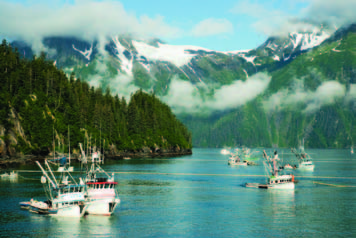Politics threaten Alaska’s world-class seafood industry
By Kati Capozzi
The Alaska seafood industry, considered one of the best managed groups of fisheries in the world, is working to move beyond a politically charged certification battle that has left those in the fishing industry frustrated, Alaska state and congressional officials fighting mad, and consumers seemingly left in the dark.
Over the last fifteen years, the terms ‘sustainable’ and ‘wild’ have become increasingly popular among conscious consumers. In response to the popular eco-friendly seafood demands, the Marine Stewardship Council (MSC) was formed in 1997, with the mission to use its ecolabel and fishery certification program to contribute to the health of the world’s oceans by recognizing and rewarding sustainable fishing practices, influencing the choices people make when buying seafood, and working with partners to transform the seafood market to a sustainable basis.
MSC turned to Alaska, known as a global leader in sustainability, to showcase and model what responsible fisheries management is. Alaska is the only state that mandates sustainable fisheries in its constitution and has led the nation in conservation management practices since statehood.
The Alaska salmon fishery was one of the first to receive MSC certification in 2000, and many other Alaska fisheries, as well as others around the country and globally, followed.
Over time, however, MSC has consistently changed its definition of what a ‘sustainable’ fishery is. As more fisheries converted to MSC certification, the conservation management requirements became inconsistent and the costs and paperwork requirements associated with certification more burdensome. The lack of a clear and consistent sustainability model, coupled with the ever increasing cost to participate in what many view as a monopolistic entity that seeks eco-control of the market, prompted the Alaska salmon fishery to let its MSC certification lapse in 2012. Many other Alaska fisheries have followed suit for the same reasons.

Alaska is a global leader in sustainable fisheries management.
(Photo: Alaska Seafood Marketing Institute)
The state is currently transitioning to a new third party certification of the UN’s Food and Agricultural Organization, “Responsible Fisheries Management” standard. The certification will provide independent assurance that Alaska’s fisheries are responsibly and sustainably managed as they have been since Statehood, or require change.
Meantime, the world’s largest food retailer, Wal-Mart, decided to only buy seafood deemed sustainable by MSC, fish in a Fishery Improvement Program, as deemed by the Sustainable Fishery Partnership (SFP) or any equivalent certification program of which currently there are none, according to Wal-Mart.
For over 50 years, Alaska has sustainably produced over half of the seafood consumed in the U.S. and over 95 percent of U.S. wild salmon, making Wal-Mart’s decision to block access to the market alarming to those in the industry and consumers alike.
In a letter sent to Wal-Mart’s President and CEO in July, Governor Parnell wrote, “Alaska has been in the business of sustainability long before MSC’s existence, managing salmon fisheries to high standards since statehood.” He continued, “No one understands more than Alaskans what it takes to protect fish stocks and their habitat. Because we have chosen, as a state, to put sustainability above profit, our historic fisheries have thrived famously, and the Alaska model serves as an example to other regions.”
Senior Wal-Mart and Sam’s Club executives recently met with representatives from the Alaska Seafood Marketing Institute (ASMI) and several state agencies to discuss Alaska seafood.
Wal-Mart has said it is fully committed to resolving the issue so it can continue to purchase Alaska salmon that meets the company’s sustainability standards. As of the writing of this article, no announcements have been made.
As reported in a recent study conducted for ASMI by the McDowell Group, fisheries production is a key economic driver in Alaska, providing more than 63,000 part-time and full-time jobs and contributing more than $6 billion to Alaska’s economy in 2011.
Return to newsletter headlines